Key takeaways:
- Understanding diversity in education is vital for fostering empathy and connection among students, enhancing classroom dynamics through shared personal experiences.
- Fostering curiosity encourages open dialogue about diversity, leading to deeper understanding and respect among peers.
- Inclusive discussions about diversity promote critical thinking, belonging, and community, as they allow students to share varying perspectives and personal narratives.
- Creating an inclusive environment requires active listening, relatable resources, and ongoing dialogue, which can build confidence and connection among students.
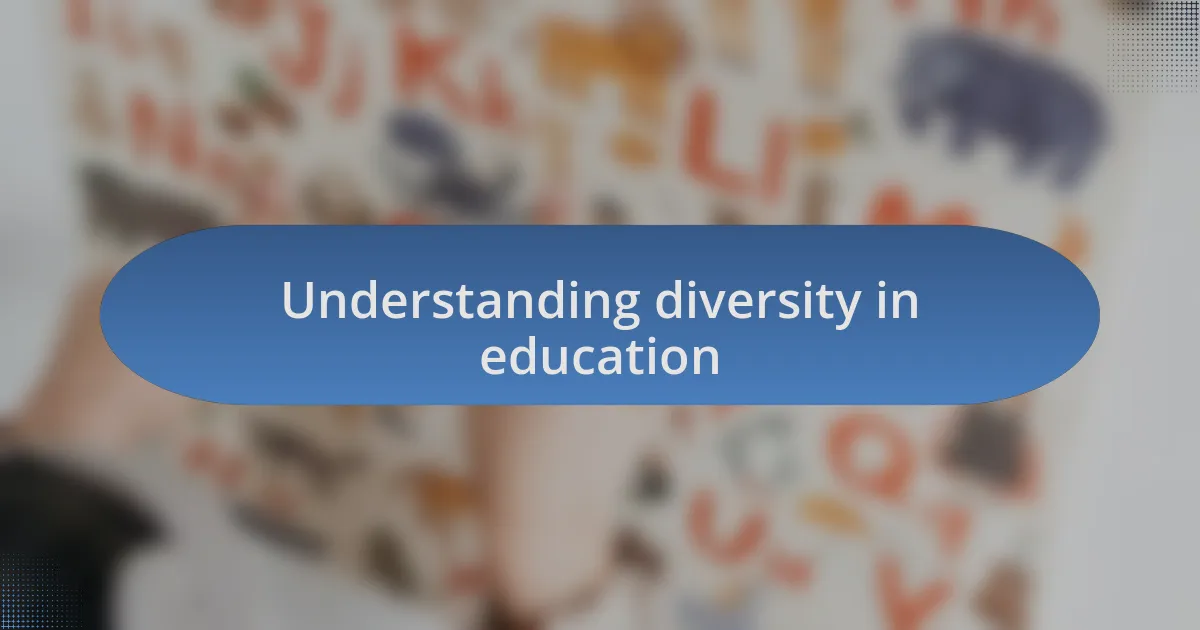
Understanding diversity in education
Understanding diversity in education is crucial, as it encompasses various dimensions including race, culture, language, and ability. I remember a moment in my teaching career when a student shared a story from her family’s cultural background. It was a simple tale, yet it opened the floor for discussions that enriched not only our classroom dynamics but also our understanding of different perspectives. How can we truly appreciate one another if we never take the time to listen and learn about each other’s experiences?
As I explored diversity, I realized it isn’t just about embracing differences; it’s about fostering an environment where every student feels valued. When I facilitated a discussion on identities, I noticed students connecting on deeper emotional levels. It’s amazing how sharing personal insights can bridge gaps and promote empathy among peers. Have you ever seen a hesitant student light up when their story resonates with others? That transformation is what makes these conversations essential.
Moreover, the challenges faced in recognizing diversity can often be profound. I recall a workshop where we talked about implicit biases and their impact on educational equity. This opened my eyes to how my own assumptions might influence my interactions with students. What steps can we take to ensure that we create inclusive spaces for every learner? By continuously questioning and reflecting on our practices, we can embrace a more inclusive educational landscape.
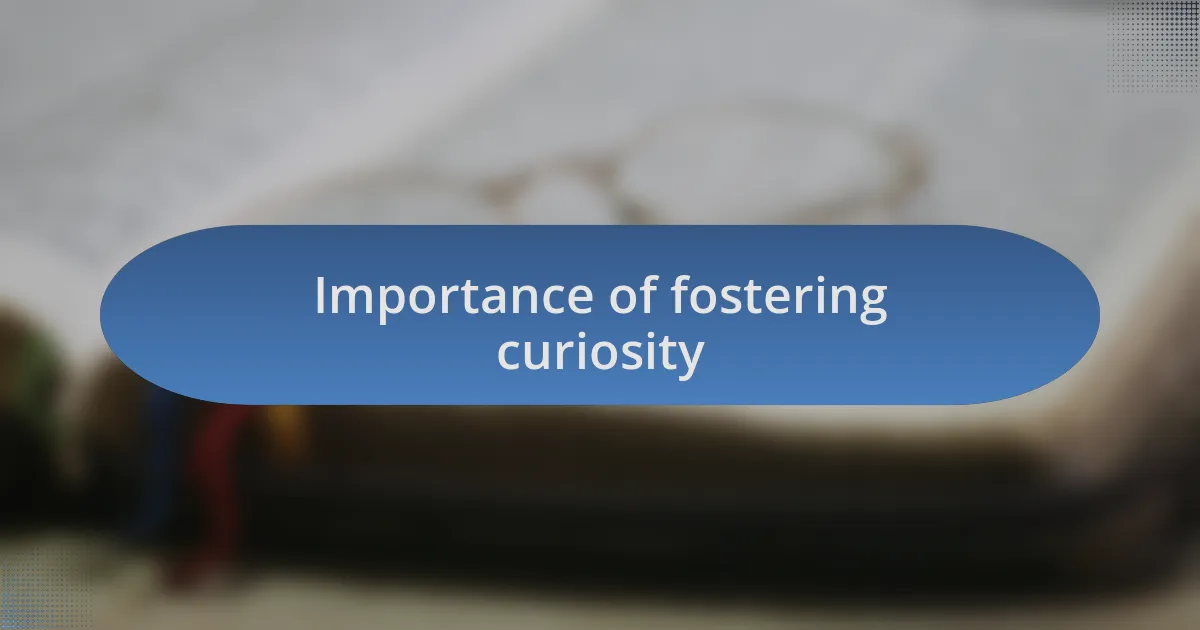
Importance of fostering curiosity
Fostering curiosity is the first step towards building an inclusive classroom. I vividly remember a day when a student passionately asked why different cultures celebrate holidays differently. That single question opened a treasure trove of discussions, allowing students to share their traditions and learn from one another. Isn’t it fascinating how one simple inquiry can create a bridge to understanding and connection?
Curiosity acts as a catalyst for empathy. During a group project, I saw a reluctant student engage deeply when their teammates encouraged them to explain their perspective. This moment wasn’t just about academic success; it transformed their relationship with peers, fostering mutual respect and understanding. How often do we miss opportunities to deepen our connections simply because we don’t encourage questions that challenge our thinking?
Moreover, nurturing curiosity enables students to become lifelong learners. I recall hosting a discussion on climate change, where students from diverse backgrounds shared unique insights based on their experiences. Witnessing their enthusiasm as they explored solutions together was truly inspiring. It made me realize that when we foster curiosity, we not only enrich our classrooms but also prepare our students for a world that thrives on collaboration and diverse perspectives.
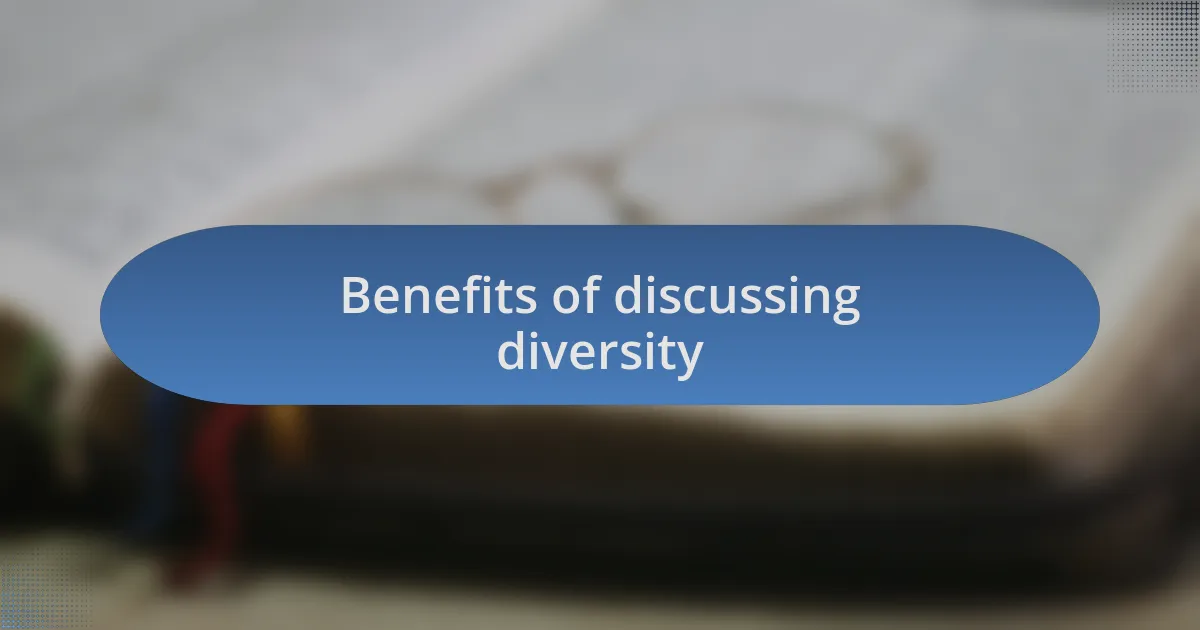
Benefits of discussing diversity
Discussing diversity brings a wealth of perspectives to the table, enhancing our understanding of the world around us. I remember a dialogue we had in class where students debated the significance of different historical events from their cultural standpoints. The insights shared were eye-opening; it struck me how enriching it was to hear so many interpretations of a single event. Doesn’t it make you wonder how much we might miss if we only view issues through a narrow lens?
Moreover, these discussions foster critical thinking and open-mindedness. During a recent workshop, I noticed students grappling with differing viewpoints on social issues. Some initially held strong opinions, but as they listened to each other, I observed a transformation. They learned not only to articulate their thoughts but also to entertain ideas that challenged their own. Aren’t those moments invaluable in shaping empathetic and well-rounded individuals?
Finally, engaging in conversations about diversity promotes a sense of belonging and community. In one memorable session, I facilitated a storytelling circle where students shared personal experiences related to their identity. This experience created a powerful bond among them, making everyone feel valued and heard. Can you imagine the potential for unity forged when we openly embrace our differences through dialogue?
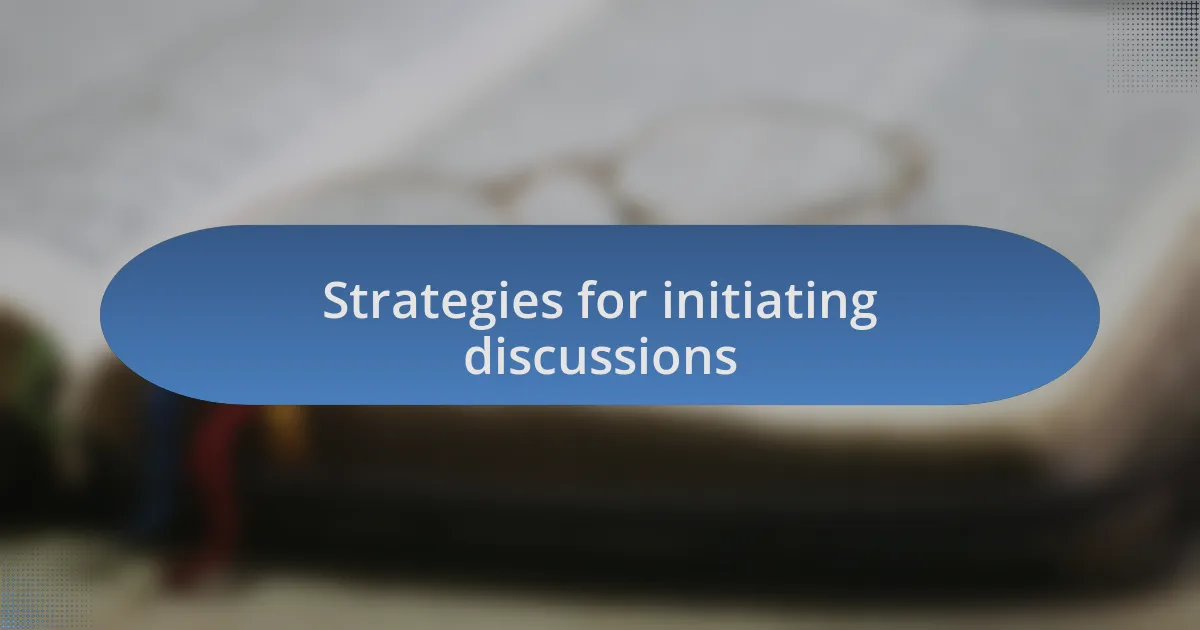
Strategies for initiating discussions
One effective strategy for initiating discussions on diversity is to start with open-ended questions that encourage personal reflection. I once asked a group of students to share their thoughts on a cultural celebration they experienced. The resulting conversation was lively; it was fascinating to hear how much joy different traditions brought into their lives. Questions like “What does this celebration mean to you?” can open gateways to profound insights and allow individuals to connect on a personal level.
Another approach is to use relatable current events or stories that highlight diversity issues. In a recent seminar, I introduced a news article about a community that united to celebrate its diverse heritage. This sparked a rich dialogue where participants shared their experiences of belonging and exclusion. It was incredible to witness how a simple article could unlock brave conversations about identity and acceptance. Isn’t it amazing how the right story can resonate with so many different perspectives?
Additionally, incorporating multimedia resources can serve as a powerful discussion starter. I remember using a short video clip that portrayed various cultural narratives. After viewing, the room buzzed with lively debates about representation and bias. Visual aids often serve as a catalyst, making the conversation feel more immediate and relevant. Have you noticed how engaging materials can spark curiosity and draw people into important discussions?
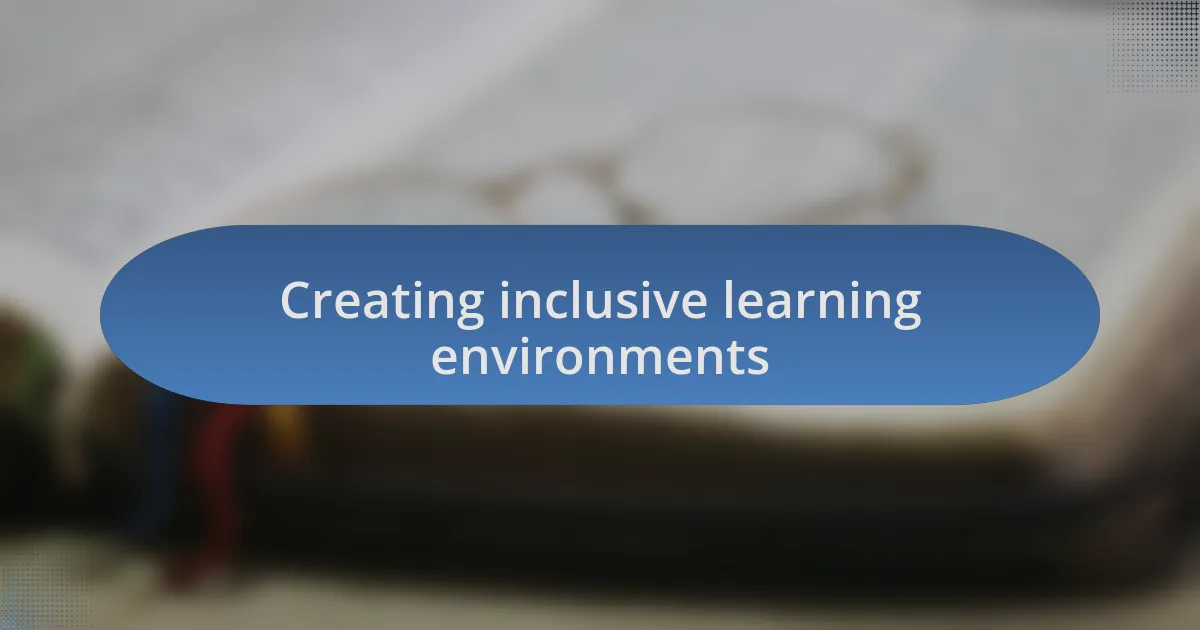
Creating inclusive learning environments
Creating an inclusive learning environment requires a genuine commitment to recognizing and validating diverse voices. I once led a workshop where I encouraged attendees to form small groups based on their cultural backgrounds. This simple act not only fostered a sense of belonging but also allowed individuals to share experiences that enriched our collective understanding. Have you ever witnessed how seeing oneself reflected in a learning space can ignite confidence and participation?
To further support inclusivity, it’s essential to create spaces for active listening. I recall a particular session where I implemented a “listening circle” format, giving everyone an opportunity to speak without interruption. The atmosphere shifted dramatically as participants felt respected and heard. How often do we underestimate the power of simply pausing to listen? It’s in those moments of silence that we can truly absorb the depth of each person’s perspective.
Moreover, integrating diverse teaching materials is crucial for fostering an inclusive environment. In one class, I introduced books from various cultures, and it was heartwarming to see students light up as they recognized familiar stories. When learning materials reflect the diversity around us, it not only validates students’ identities but also broadens everyone’s worldview. Can you recall a moment when a particular text or resource connected deeply with you and transformed your understanding?
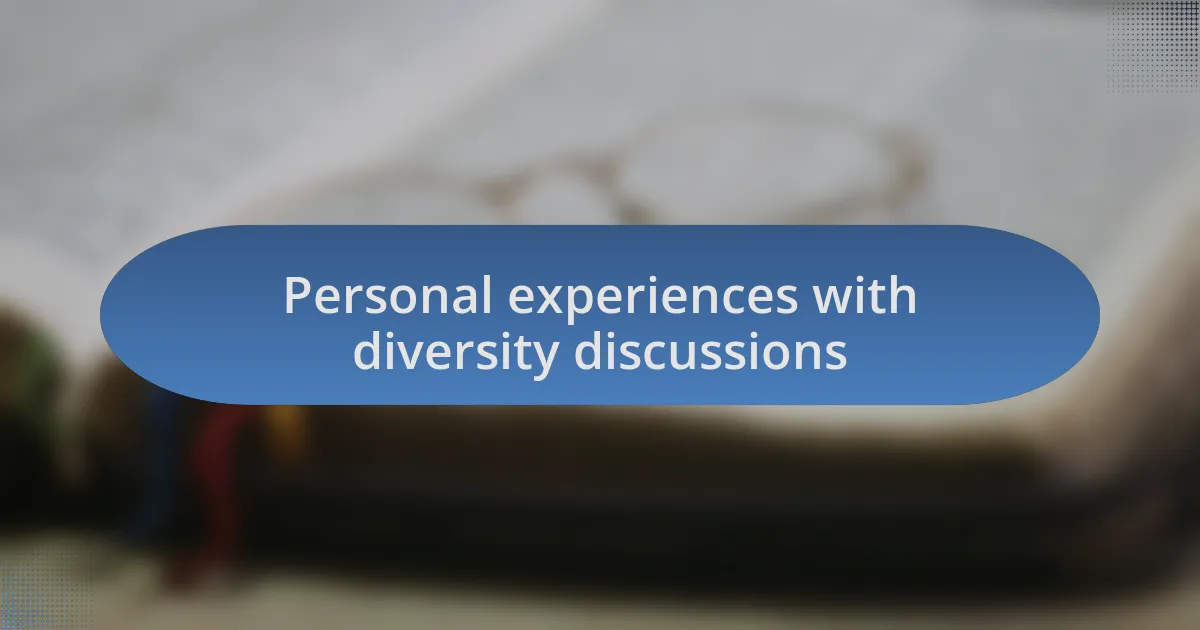
Personal experiences with diversity discussions
Engaging in discussions about diversity has always been a profound experience for me. I remember a panel I organized where speakers from different backgrounds shared their stories. One speaker, in particular, moved me with her account of overcoming prejudice in her career. Her strength and resilience sparked an incredible dialogue among the attendees, making me realize how impactful personal narratives can be in shaping our understanding of diversity.
In another instance, during a coffee break at an educational conference, I started chatting with a fellow educator from a different cultural background. Our conversation turned into a deep dive about our contrasting teaching philosophies and how our cultural experiences shaped our approaches to education. It struck me how even casual conversations could bridge gaps and foster curiosity about each other’s perspectives. Have you ever found unexpected insights in a simple chat?
I’ve also discovered that humor can be a powerful tool in diversity discussions. Once, while leading a workshop, I used a light-hearted anecdote about misunderstandings arising from cultural differences. The laughter that ensued broke down barriers and opened up the floor for more serious conversations. It made me think: how can humor help us navigate the sometimes uncomfortable terrain of discussing diversity? Through laughter, we began to connect on a deeper level, setting the stage for meaningful dialogue.
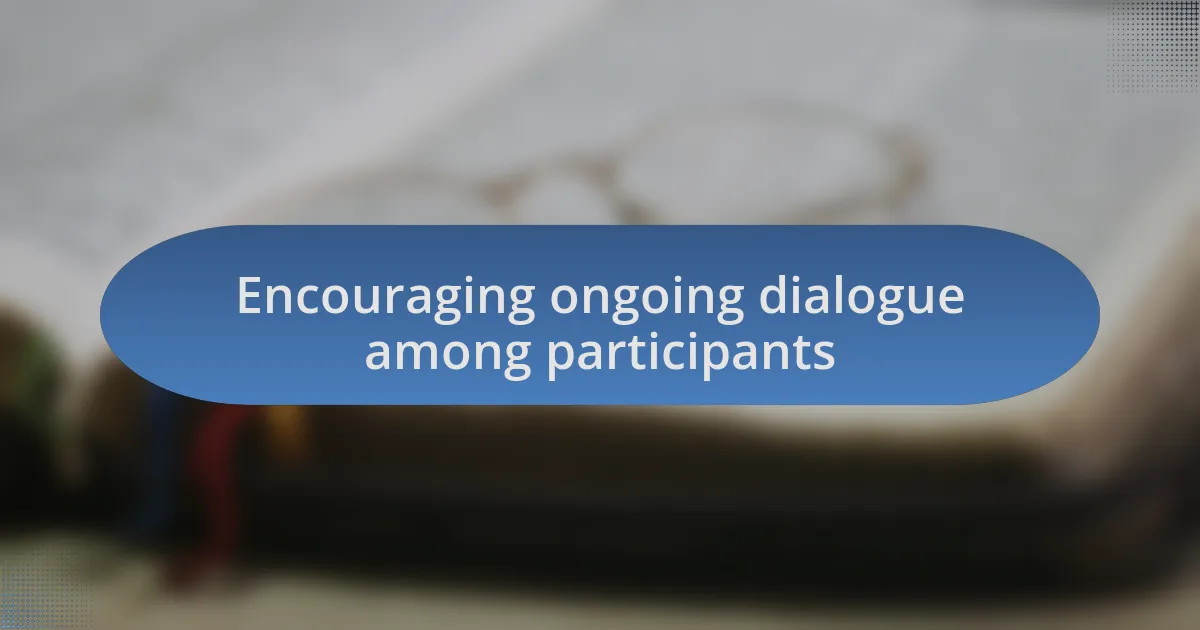
Encouraging ongoing dialogue among participants
Creating an environment where ongoing dialogue thrives is essential for fostering curiosity about diversity. I recall a workshop I attended where participants were encouraged to share their thoughts in small groups after each session. This structured approach not only allowed everyone to voice their opinions but also highlighted varying perspectives. Have you ever noticed how sharing in smaller settings can feel less intimidating? It creates a space where individuals are more likely to open up and engage deeply.
One time, during a facilitator training, we were reminded to check in with participants regularly, asking questions to ensure that everyone felt included. By actively seeking feedback, we sparked conversations that revealed layers of understanding around diverse experiences. It truly underscored the idea that curiosity flourishes when we invite continued dialogue. How often do we really take the time to ask others what they think when discussing complex topics like diversity?
Furthermore, I’ve found that incorporating story circles—not just in formal settings but also in informal gatherings—can significantly enhance dialogue. In one instance, I hosted a dinner where guests shared personal anecdotes about their cultural experiences. The warmth of the gathering, paired with storytelling, deepened connections and led to spontaneous discussions that lasted well into the night. It was a beautiful reminder that conversations about diversity not only educate us but also unite us through shared humanity. What stories would you share if given the chance?